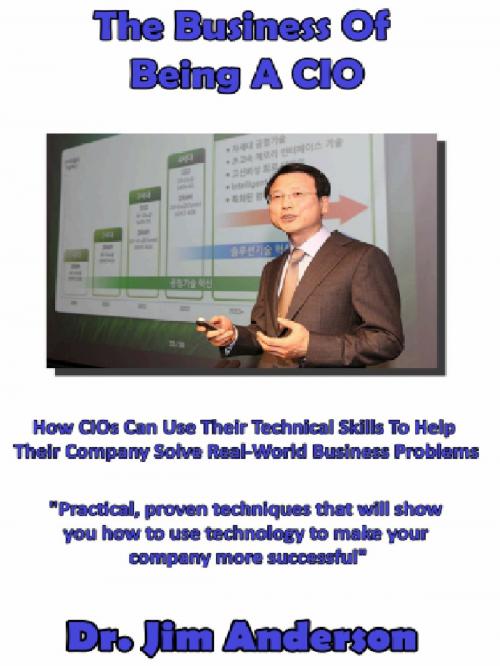The Business Of Being A CIO: How CIOs Can Use Their Technical Skills To Help Their Company Solve Real-World Business Problems
Business & Finance, Management & Leadership, Management| Author: | Jim Anderson | ISBN: | 9781503293434 |
| Publisher: | Jim Anderson | Publication: | December 5, 2014 |
| Imprint: | Smashwords Edition | Language: | English |
| Author: | Jim Anderson |
| ISBN: | 9781503293434 |
| Publisher: | Jim Anderson |
| Publication: | December 5, 2014 |
| Imprint: | Smashwords Edition |
| Language: | English |
All too often CIOs can get caught up in all of the technical details of the job: boosting uptime, replacing servers, guarding against cyber criminals, etc. What we tend to forget is that IT exists to serve the rest of the business and they are there (in most cases) to make money. This means that there needs to be a business side to IT and that is one of a CIO's key responsibilities.
What You'll Find Inside:
* 10 WAYS THAT IT CAN SOLVE REAL-WORLD BUSINESS PROBLEMS
* ARE CIOS LOOKING DOWN WHEN THEY SHOULD BE LOOKING UP?
* 3 WAYS TO FIX AN IT DEPARTMENT (SUGGESTIONS FROM EUROPE)
* HOW CAN YOU MAKE YOUR IT DEPARTMENT STRATEGIC
The business is always facing a set of business problems. What you need to do as a CIO is to take the time to understand how these problems appear to the rest of the company. Then you need to use your technical skills to identify ways that the IT department can help the company solve these problems.
This is going to have a huge impact on how you accomplish your CIO job. Your focus is going to have to shift from your department to watching over the rest of the company. Your top concerns are going to have to be business based, not technology based.
In order to be a successful business based CIO, you need to establish clear lines of communication with the rest of the departments in the company. This means that the way that you talk about IT is going to have to change. No longer can you use the technical shorthand lingo that is used within IT, instead you are going to have to simplify things for everyone else.
In the end it has to be your goal to transform the IT department. Gone are the days when you could simply be a support arm of the company fixing email systems and laptops. Now you need to become the strategic partner that the rest of the firm is going to have to rely on in order to accomplish their business goals.
This book has been written in order to provide you with an understanding of how you can use your technical skills to solve business problems for your company. Follow the suggestions in this book and you'll transform your IT department into a powerful competitive tool for the rest of the firm to use.
All too often CIOs can get caught up in all of the technical details of the job: boosting uptime, replacing servers, guarding against cyber criminals, etc. What we tend to forget is that IT exists to serve the rest of the business and they are there (in most cases) to make money. This means that there needs to be a business side to IT and that is one of a CIO's key responsibilities.
What You'll Find Inside:
* 10 WAYS THAT IT CAN SOLVE REAL-WORLD BUSINESS PROBLEMS
* ARE CIOS LOOKING DOWN WHEN THEY SHOULD BE LOOKING UP?
* 3 WAYS TO FIX AN IT DEPARTMENT (SUGGESTIONS FROM EUROPE)
* HOW CAN YOU MAKE YOUR IT DEPARTMENT STRATEGIC
The business is always facing a set of business problems. What you need to do as a CIO is to take the time to understand how these problems appear to the rest of the company. Then you need to use your technical skills to identify ways that the IT department can help the company solve these problems.
This is going to have a huge impact on how you accomplish your CIO job. Your focus is going to have to shift from your department to watching over the rest of the company. Your top concerns are going to have to be business based, not technology based.
In order to be a successful business based CIO, you need to establish clear lines of communication with the rest of the departments in the company. This means that the way that you talk about IT is going to have to change. No longer can you use the technical shorthand lingo that is used within IT, instead you are going to have to simplify things for everyone else.
In the end it has to be your goal to transform the IT department. Gone are the days when you could simply be a support arm of the company fixing email systems and laptops. Now you need to become the strategic partner that the rest of the firm is going to have to rely on in order to accomplish their business goals.
This book has been written in order to provide you with an understanding of how you can use your technical skills to solve business problems for your company. Follow the suggestions in this book and you'll transform your IT department into a powerful competitive tool for the rest of the firm to use.















